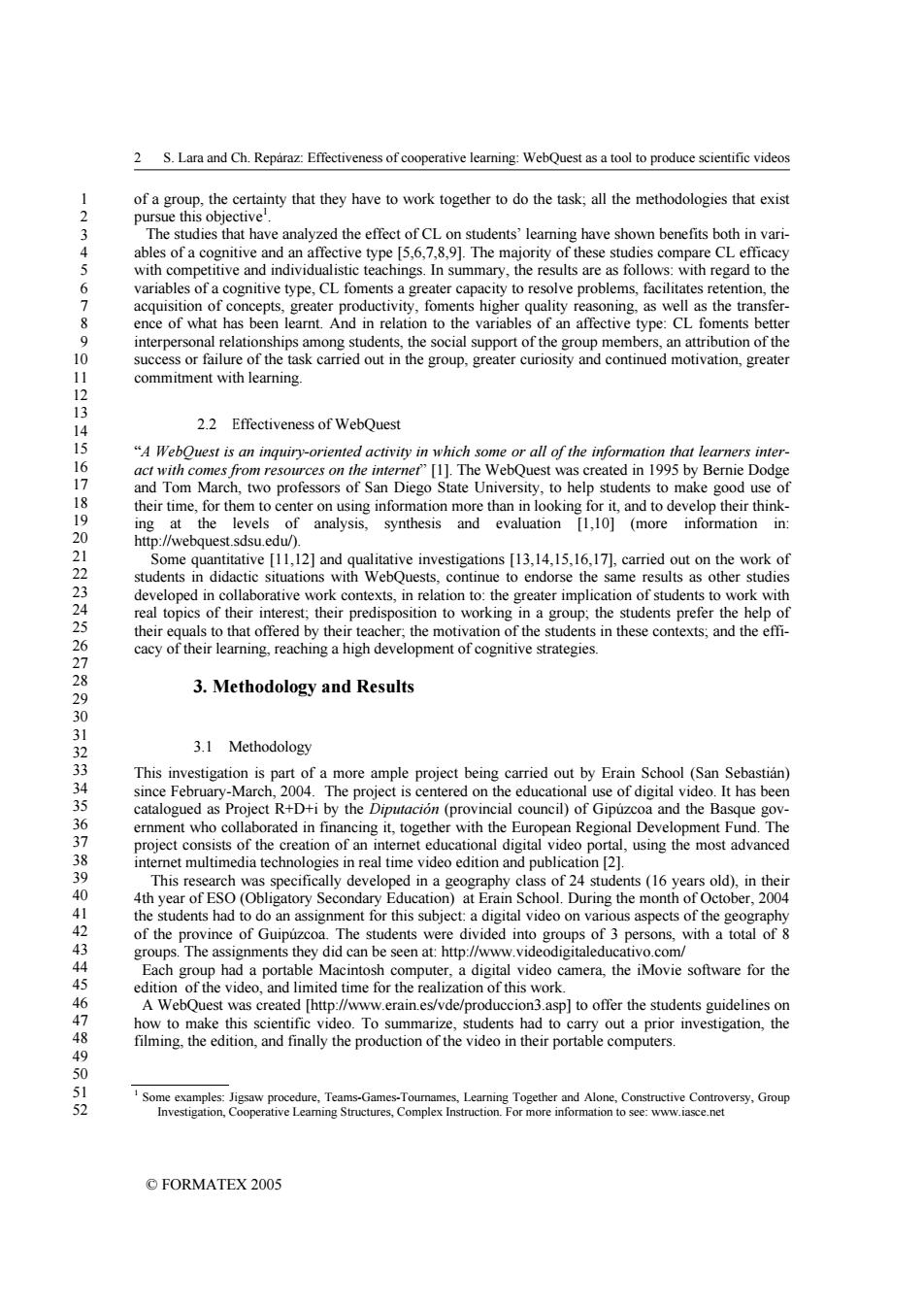正在加载图片...

2 S.Lara and Ch.Reparaz Effectiveness of cooperative leaming:WebQuest as a tool to produce scientific videos of a group.the certainty that they have to work together to do the task:all the methodologies that exist The studies that have analyzed the effect of CL on studentsleaming have shown benefits both in vari- 8 ence of what has been eamt.And in relation to the varables of type:CL foments bette commitment with learning. 1234 2.2 Effectiveness of WebQuest act evels of analysis.synthesis and evaluation (more informationin http://webquestsd tive nestioations 1314 15 16 17 carried out on the WebQuests,oinue to 34 rel opi of their inter nts in these contexts;and the eff 3.Methodology and Results 30 3.1 Methodology 34567 catalogued as Project by the 890 41 http:/ e software for the to offer the studer 4 to make this scie video.To summarize students had to c FORMATEX 2005 2 S. Lara and Ch. Repáraz: Effectiveness of cooperative learning: WebQuest as a tool to produce scientific videos 1 2 3 4 5 6 7 8 9 10 11 12 13 14 15 16 17 18 19 20 21 22 23 24 25 26 27 28 29 30 31 32 33 34 35 36 37 38 39 40 41 42 43 44 45 46 47 48 49 50 51 52 © FORMATEX 2005 of a group, the certainty that they have to work together to do the task; all the methodologies that exist pursue this objective1 . The studies that have analyzed the effect of CL on students’ learning have shown benefits both in variables of a cognitive and an affective type [5,6,7,8,9]. The majority of these studies compare CL efficacy with competitive and individualistic teachings. In summary, the results are as follows: with regard to the variables of a cognitive type, CL foments a greater capacity to resolve problems, facilitates retention, the acquisition of concepts, greater productivity, foments higher quality reasoning, as well as the transference of what has been learnt. And in relation to the variables of an affective type: CL foments better interpersonal relationships among students, the social support of the group members, an attribution of the success or failure of the task carried out in the group, greater curiosity and continued motivation, greater commitment with learning. 2.2 Effectiveness of WebQuest “A WebQuest is an inquiry-oriented activity in which some or all of the information that learners interact with comes from resources on the internet” [1]. The WebQuest was created in 1995 by Bernie Dodge and Tom March, two professors of San Diego State University, to help students to make good use of their time, for them to center on using information more than in looking for it, and to develop their thinking at the levels of analysis, synthesis and evaluation [1,10] (more information in: http://webquest.sdsu.edu/). Some quantitative [11,12] and qualitative investigations [13,14,15,16,17], carried out on the work of students in didactic situations with WebQuests, continue to endorse the same results as other studies developed in collaborative work contexts, in relation to: the greater implication of students to work with real topics of their interest; their predisposition to working in a group; the students prefer the help of their equals to that offered by their teacher; the motivation of the students in these contexts; and the efficacy of their learning, reaching a high development of cognitive strategies. 3. Methodology and Results 3.1 Methodology This investigation is part of a more ample project being carried out by Erain School (San Sebastián) since February-March, 2004. The project is centered on the educational use of digital video. It has been catalogued as Project R+D+i by the Diputación (provincial council) of Gipúzcoa and the Basque government who collaborated in financing it, together with the European Regional Development Fund. The project consists of the creation of an internet educational digital video portal, using the most advanced internet multimedia technologies in real time video edition and publication [2]. This research was specifically developed in a geography class of 24 students (16 years old), in their 4th year of ESO (Obligatory Secondary Education) at Erain School. During the month of October, 2004 the students had to do an assignment for this subject: a digital video on various aspects of the geography of the province of Guipúzcoa. The students were divided into groups of 3 persons, with a total of 8 groups. The assignments they did can be seen at: http://www.videodigitaleducativo.com/ Each group had a portable Macintosh computer, a digital video camera, the iMovie software for the edition of the video, and limited time for the realization of this work. A WebQuest was created [http://www.erain.es/vde/produccion3.asp] to offer the students guidelines on how to make this scientific video. To summarize, students had to carry out a prior investigation, the filming, the edition, and finally the production of the video in their portable computers. 1 Some examples: Jigsaw procedure, Teams-Games-Tournames, Learning Together and Alone, Constructive Controversy, Group Investigation, Cooperative Learning Structures, Complex Instruction. For more information to see: www.iasce.net